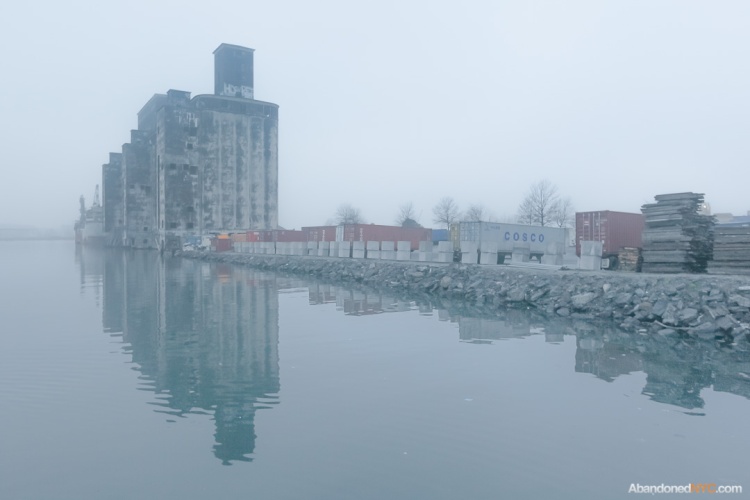
On foggy mornings, nothing can rival the Grain Terminal’s spectral allure.
It’s been nearly fifty years since a freighter docked at the Red Hook Grain Terminal; now black mold overspreads its concrete silos like a mourning veil.
Its origin can be traced to the turn-of-the-century construction of the New York State Barge Canal, which widened and rerouted the Erie Canal at great expense to facilitate the latest advances in shipping. By 1918, New York City was lagging behind in the nation’s grain trade, and the canal was failing, operating at only 10% of its capacity. A new facility was built in the Port of New York to invigorate the underused waterway—a state-run grain elevator in the bustling industrial waterfront of Red Hook, Brooklyn.
The structure is largely composed of 54 circular silos with a combined capacity of two million bushels. Grain was mechanically hoisted from the holds of ships, elevated to the top of the terminal, and dropped into vertical storage bins through a series of moveable spouts. When a purchase was made, the force of gravity would release the grain from the bins, at which point it was elevated back to the top of the terminal and conveyed to outgoing ships.
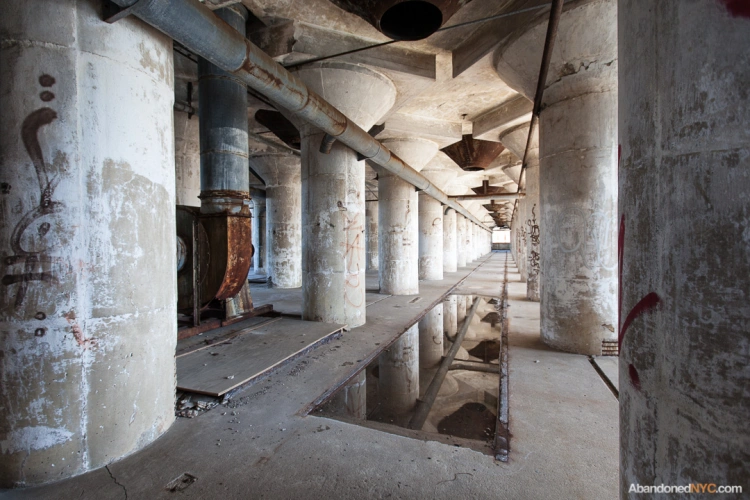
A shallow puddle makes an effective reflecting pool after a downpour, in keeping with the monumental atmosphere of the place.
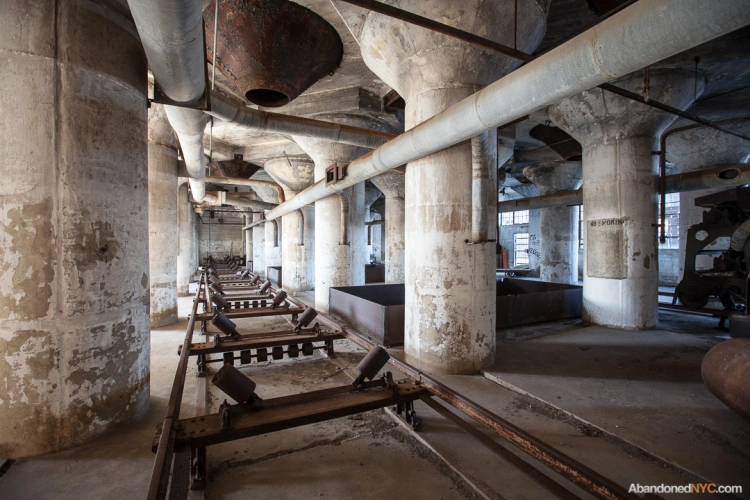
Packed with rows of white columns, the ground floor resembles an ancient house of worship.
Red Hook’s grain elevator is one of many similar structures built across the country in the 1920s, most notably in Buffalo, NY. Guided by practical concerns and the laws of nature, American engineers had arrived at a new style of architecture, making a lasting impression on European architects. In Toward an Architecture (1928), Le Corbusier called the American elevators “the first fruits of a new age.” Their influence can be traced through the Brutalist movement of the 50s and 60s, through which inexpensive, unadorned cement structures dominated post-war reconstruction in Europe.
The Grain Elevator was an engineering marvel, but never became a commercial success. The structure quickly became obsolete in the mid-20th century as grain trade in the Port of New York steadily declined from 90 million bushels a year in the 1930s to less than 2 million in the 1960s. Contractors grew to avoid the New York Harbor, where the cost of unloading grain came to three to four times the rate of competing ports in Baltimore, Philadelphia, and New Orleans, largely due to local union restrictions.
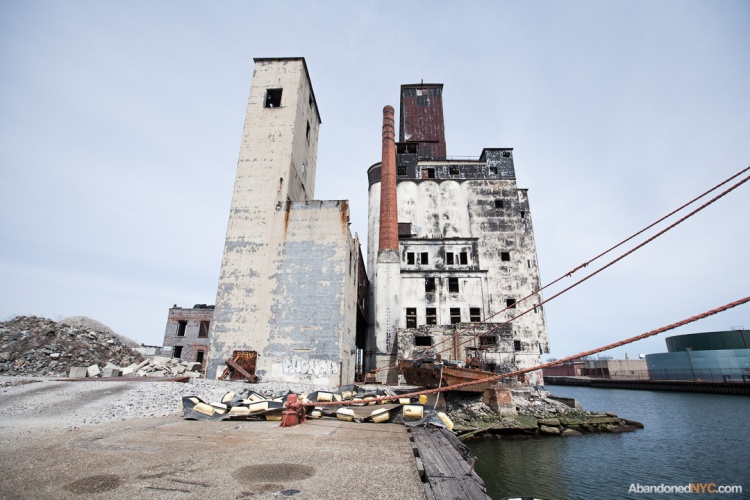
The Grain Terminal was emptied of its last bushel in 1965.
The collapse of the grain trade made up a small part of an overall decline along Red Hook’s industrial waterfront in the second half of the 20th century as shipping methods evolved and moved elsewhere. When the jobs dried up, much of the area cleared out, leaving a slew of vacant warehouses and decaying docks. In the year 2000, most of Red Hook’s 10,000 residents lived in the Red Hook Houses, one of the city’s first public housing projects. The development was a notorious hotbed for crack cocaine in the 80s and early 90s, but conditions have gradually improved over the years. A near complete lack of major subways and buses stalled gentrification in the neighborhood, but signs are becoming more common. Today, Van Brunt Street is scattered with specialty wine bars, cupcake shops, and craft breweries, and a big box IKEA store opened in 2007 on the site of a former graving dock.
The Grain Terminal has been the subject of a number of reuse proposals over the years, but none of the plans have amounted to real progress at the site. The building sits on the grounds of the Gowanus Industrial Park, which currently houses a container terminal and a bus depot, among other industrial tenants. The owner is now seeking approval for a controversial plan to extend his property into the bay with landfill, using a concoction of concrete and toxic sludge dredged from the floor of the Gowanus Canal.
As battles wage over the future of the property, the Red Hook Grain Terminal hovers over the Henry Street Basin like a grieving ghost on a widow’s walk, watching for ships that will never return…
A word to the wise: the grounds of the Grain Terminal are patrolled by security, and they’re cracking down on trespassers.
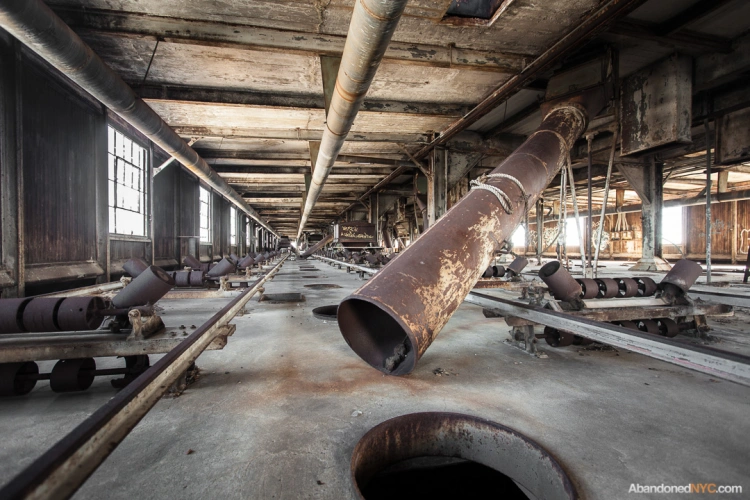
Moveable spouts delivered grain to individual silos.
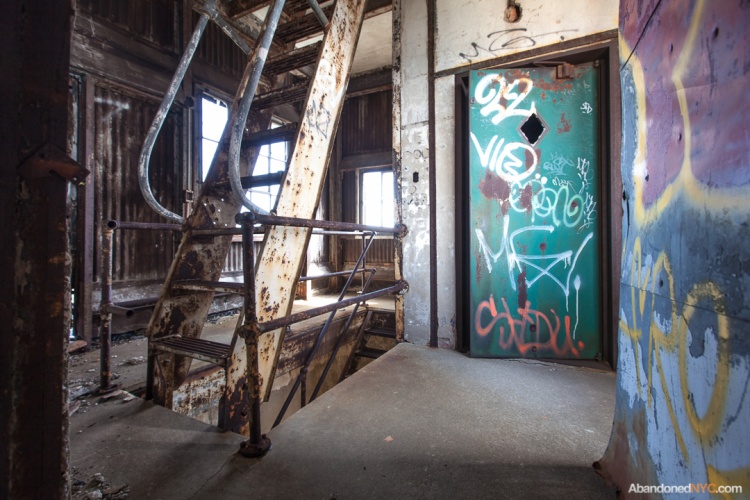
A 90-foot staircase of corroded metal slats connects the first floor to the top of the storage bins.
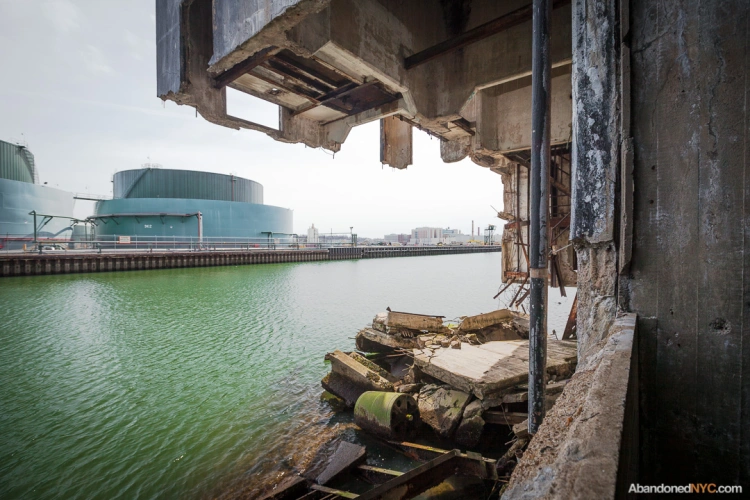
The lower levels of two out of three staircases have collapsed into the basin…
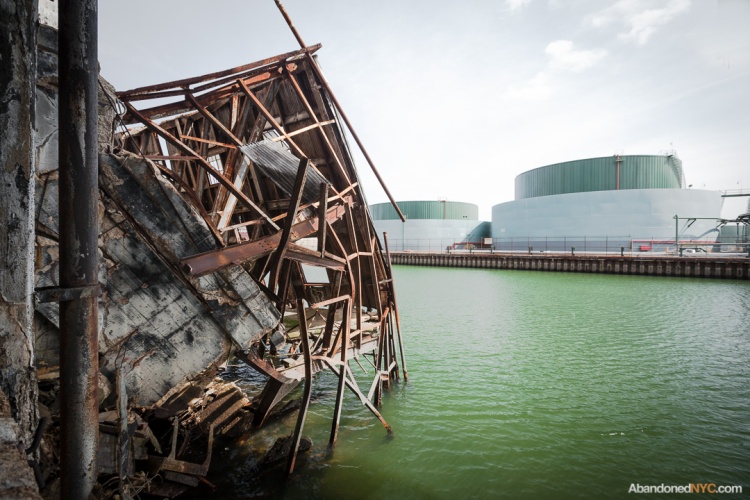
Whole sections of the building are on their last legs…
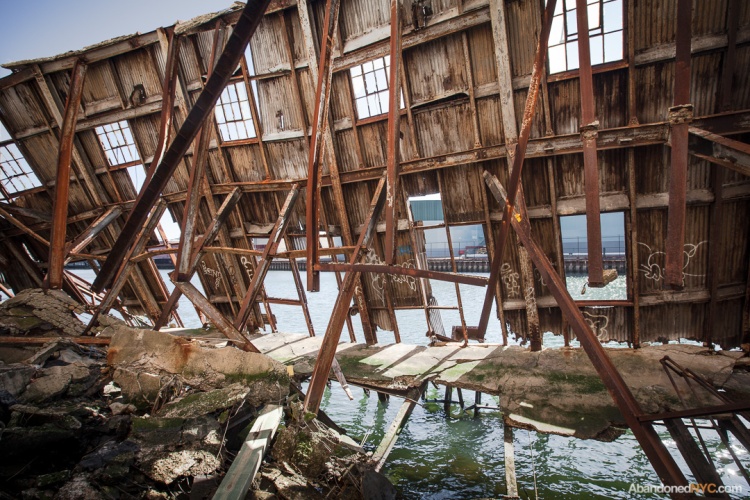
..crumbling into the canal like a latter-day House of Usher.
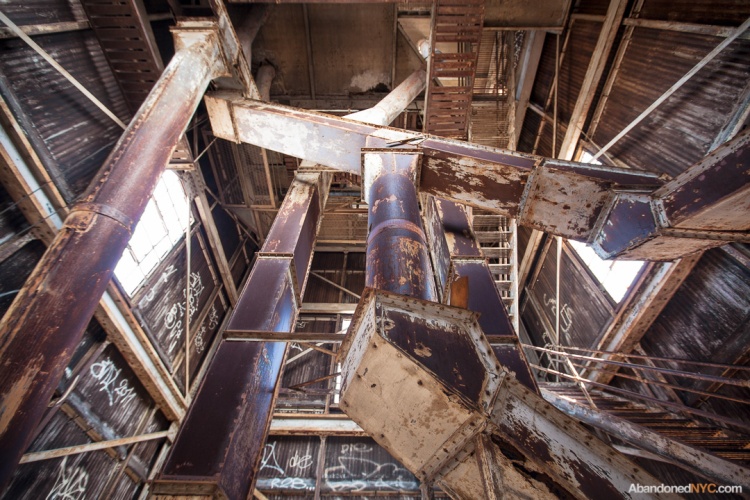
The building is topped by a small tower on the north end…

…and a larger structure to the south.
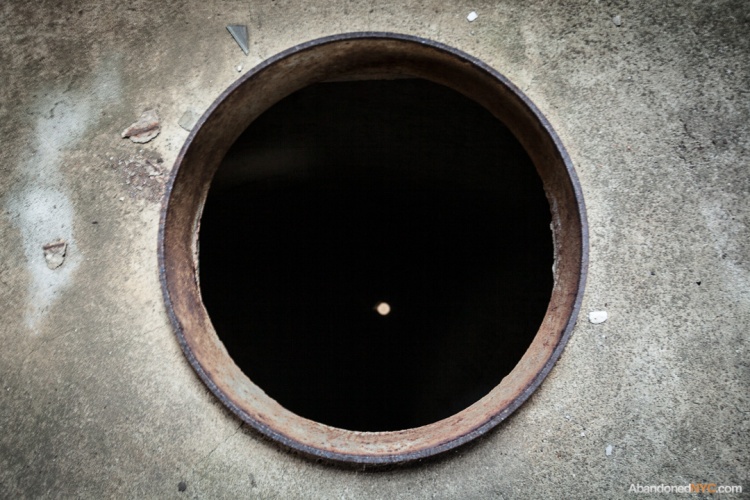
The top floor is strewn with manhole-sized apertures, which give way to the mind-numbing vacuum of the empty grain silos.
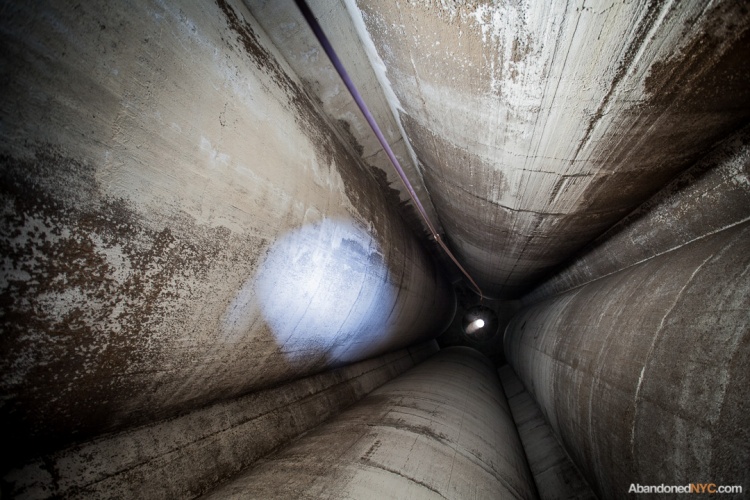
Looking down these is like staring into the face of death.
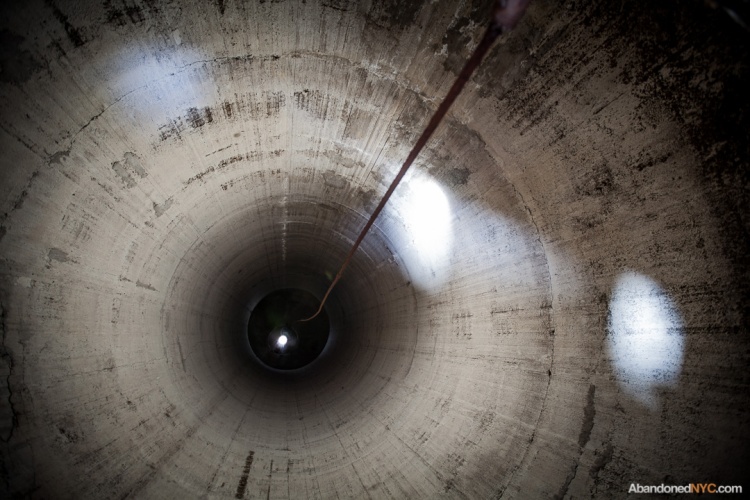
It’s a looooong way down.


Beautiful..thanx
LikeLike
Posted by kc2mei@yahoo.com | 8-12-13., 8:01 amGreat photos! Thanks so much for sharing.
Best regards,
William Miller
On Mon, Aug 12, 2013 at 6:42 AM, AbandonedNYC
LikeLike
Posted by wmsmiller | 8-12-13., 9:17 amFantastic photos and history! Thanks for sharing….love your blog!
LikeLike
Posted by Pattie Crider | 8-12-13., 3:54 pmThese are amazing photos!!! Thank you for sharing this!!! 🙂
LikeLike
Posted by zeenyc75 | 8-12-13., 7:28 pmNice! Love that session…
LikeLike
Posted by Iago | 8-12-13., 8:05 pmLove your blog and photos. Thanks for sharing the background, very interesting. You photos made my legs weak ‘looking down’ a long way…yikes!
LikeLike
Posted by Tanya | 8-12-13., 11:12 pmI always look forward to your new posts…always great narrative and fantastic photos….thanks so much
LikeLike
Posted by Frank | 8-13-13., 6:02 amBeautiful work, thank you so much.
LikeLike
Posted by Jeannie | 8-13-13., 6:35 pmDo not fall in
LikeLike
Posted by Pipe Adams | 8-14-13., 10:40 pmwent there a few days ago. people, he’s not kidding. security is ridiculous. we had to leave through the gowanus. and still got in minor trouble.
also in order to actually get to the upper stories, you need to ninja your way up a dangling bannister, around a locked door, and onto a small cement platform. proceed with caution!
LikeLike
Posted by roryminelor | 8-15-13., 1:24 amNice to see you again roryminelor, my little trespasser! Just a random dare you say ; )
it’s called aiding and abetting – it will get you a lot more than a desk appearance ticket
LikeLike
Posted by ujhhg | 8-19-13., 10:18 pmWent there twice recently. First day, no problems at all, got some good photos. Second day, we got caught. They are looking for people who are going in during low tide, so DO NOT GO during low tide
LikeLike
Posted by explorer | 8-19-13., 5:36 pmdudes, we got you with the police, should we start a civil action next? so much for your random check out of cool buildings
LikeLike
Posted by ujhhg | 8-19-13., 10:09 pmThanks so much for this! As a former Ohio farmgirl, I’ve wondered about this building so many times, and your photos and description entirely do it justice.
LikeLike
Posted by Unapologetically Mundane | 8-21-13., 5:34 pmValentines day David Bowie’s video was filmed in there
LikeLike
Posted by eric cast | 8-25-13., 1:21 pmLaw & Order SVU filmed an episode here that aired last week. Some sick guy kidnapped a little girl & held her upstairs somewhere & used her to lure Det. Benson. Awesome to have watched it knowing exactly where it was.
LikeLike
Posted by Maduro | 7-16-14., 5:26 pmHere is a short Video of the same place: https://vimeo.com/109818661
LikeLike
Posted by Imperfect Cinema | 10-23-14., 12:19 pmAlso great article and wonderful blog!
LikeLike
Posted by Imperfect Cinema | 10-23-14., 12:21 pmSince the ship has been used in several films recently I was wondering about its history.
LikeLike
Posted by Anonymous | 11-4-16., 4:12 pmRecognizable as the set for nunerous films, TV episodes. Does longitude latitude of The Grain Terminal align with Lady Liberty? Appears to from the Gowanus expressway.
LikeLike
Posted by AnnaMara | 5-12-17., 9:30 amThis location is amazing! Perfect for a shoot I am working on – anyone have a contact to obtain a filming permit?
LikeLike
Posted by Alessia | 3-8-18., 8:25 amDid you ever find the contact for this? I’ve been email and asking around for weeks with no avail. Thanks in advance!
LikeLike
Posted by Carrie | 10-16-18., 6:02 pm